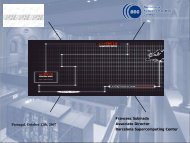e-<strong>Infrastructures</strong> <strong>Roadmap</strong>Directions to: Software life cycle managementThe e-Infrastructure would be incomplete without software. Scientific software acts as a skeletalframework for many scientific developments, as its implements incremental knowledge, approaches,algorithms and models available. Often, specific scientific codes are used by dozens or even hundredsof groups and thousands of scientists across Europe and the rest of the world – with a life span ofsometimes several decades. The software is in some areas – where complexity has risen to the pointthat researchers cannot but depend on the validity and accuracy of the code – becoming the mostimportant carrier of scientific insights.There are two realms of codes: the first is owned by privately or publicly held companies, and requiressignificant fees to use them. In a way these act as scientific publishers, incorporating the knowledgediscovered by others into the software. This creates a number of problems, one of which is that oneparty decides where innovation can take place, which architectures are supported and optimised for.In a grid environment such features are undesirable, as they shrink the available set of resources.People also tend to have the same problematic relationship as with more classical scientific publishers:since many scientists are dependent on the codes they run for maintaining their pace of publication,financially draining the community to the point of extortion is lying around the corner. CurrentIntellectual Property Right solutions are not in the interest of science. The only exit-scenario is torebuild from scratch as a community effort, which is very time-consuming as these codes have beenworked on for many man years and the internals of the software are unclear to outsiders. Even if someuser communities of non-public codes would embark on such a scenario, this would still requiremore support for them for the next few years. For others, leveraging the buying power of the jointEuropean users is essential.The second realm of code is the software that is in the purely scientific domain. Many software isspawned rather organically from small-scale initiatives – quite often individual PhD-projects. Manyof these codes have however outgrown their initial use and development scope, and the creators fallvictim to their own success. Individual research groups that are now responsiblefor maintaining thecodes – as good or as bad as possible – take considerable pride in providing such a service to thecommunity. But they cannot be expected to pay for the whole development for years or even decadesby themselves. At some point the software reaches a critical stage for their user communities: howdoes it continue to develop? Implementing other peoples algorithms, fine-tuning and optimising thecode for new user groups and software environments and debugging – in short keeping the code upto date and usable to all – lack the imaginative force of new discovery.Despite the importance of such codes and their widespread use, they often lack adequate developmentsupport or even a basic life cycle management infrastructure. It is not that people aren’t seeing theimportance of maintenance, optimisation and further development. On the contrary, but such activitiesare outside the scope of the basic funding structure and national orientation of most research fundingagencies. In fact, software costs – including those of commercial codes – are systematically off radar.That it is problematic is very clear, when we are about to enter an era where e-Science is to blossom.Solutions at the EU level are needed; software crosses boundaries and local solutions are inefficient.There are three scenarios: the first is to leave the software as is, and just let it loose on a large scale onthe e-Infrastructure. This will at best just maintain inefficiency, and thereby invisibly occupy resourcesequivalent to significant amounts of money. If no investments are made, the science behind the softwarewill suffer. At worst the community suffers from an accumulation of systematic programming errors,resulting in large scale scientific errors undetectable until someone does build another correctimplementation or version of the software. This is obviously penny-wise and pound-foolish.The second scenario is to commercialize all the individual software packages. This may pay for somehard needed initial changes and be economically sustainable in the future, but it is both hard todo from a legal point of view (since so far everything was built with public funds and with thecontributions of many) and would create other problems. Commercialising would for instance takeaway the code from the open source domain – which is important for progress as it allows scientificscrutiny and the discovery of errors on the one hand and enables innovative dispute on the other. Andof course it will bring about the problems described earlier as the software enters the commercialrealm: reducing the amount of architectures and software environments supported and deliveringscientists to the mercy of their software publisher.A third option would be to create some structural funds in order to have professional softwareengineers and scientists take the responsibility together for building, maintaining and consolidatingscientific code. This seems the best solution. After all, not all scientists are programmers.In both realms things are about to change because of the grid. In order to work in the newconstellation with the grid middleware and new devices being brought in, significant changes willhave to be made. We should leverage this, equivalent to the leveraging of the Y2K-situation that ledto a significant upgrade of legacy installed base in the last years of the previous millennium.26 27
e-<strong>Infrastructures</strong> <strong>Roadmap</strong>Next turnY Develop recommendations for commercial software to interact with the European Science Grid.Y Set up a support scheme on how to implement and use codes in grids.Y Develop adequate regulatory framework for commercial software licensing to protect usercommunities.Y Identify the most important open software codes and initiate a group of professional softwareengineers to achieve quick wins on these codes together with the user communities, and enablethem to run within the grid environment.Directions to: Middleware repositories and parameter registrationGrids are very dynamic environments, with continuous shifts in software and middleware components,data formats and other parameters. In order to be able to replicate certain findings, one needs to makesure certain historical information is available. For data that is being used, this is done through theEuropean Storage facilities. We have also discussed software curation at the level of scientific codes.But what about the grid middleware itself? How can we preserve historical versions of middlewarecomponents and be able to find up to date versions that are compatible? How do we deal withparameters such as historical credentials or the inclusion of real time data from sensor grids?End destinationY Structural financial support for use and maintenance of scientific code, and the implementationof novel algorithms.Y Modularisation and decentralised development for open and closed codes through a Europeansoftware repository.Relevant policies, organisations, activities:Y DG Information <strong>Society</strong> and Media, DG Research, scientific software publishers, open sourcedevelopers, user groups.A first requirement is that it would be very beneficial to have a central register which allocates uniqueparameters, name spaces, formats and schemas as used by grid applications. In scope and activities thiswould be quite similar to the functions that IANA performs for the internet; such data would haveto be available on-line at a fixed URI in a machine-processable way (such as RDF). This bookkeeperfor grid settings should probably try to operate on a global scale, and not exclude commercialparameters per se in order to gain global focus. This only works at the highest level, therefore it shouldbe complemented by decentralized or local documentation of such data through semantic annotation,which will help maintain flexibility and thus may also play an important role to help organize,orchestrate or at the very least least interface with services that are offered.One other requirement is that the actual grid middleware components used in the European ScienceGrid remain available over a long period of time. Much of these components are open source, whichgreatly simplifies their archiving. 16 Several individual European countries already have comprehensivemiddleware repositories that actually serve a double function: since they contain all available componentsfrom historical ones until the current state of the art counterparts people can use these repositoriesto obtain suitable open source Grid middleware solutions. To that extent these repositories providecomprehensive information about the function, reliability and usability of every component. This isa time-consuming but important task.Another role these middleware institutes have taken up is to provide quality-assured softwareengineering, testing, packaging and maintenance of software. As such they coordinate and partlyfinance work being done on software to make it faster and more reliable, and easy to both install anduse. They also coordinate collaboration with industry. A European superstructure of middlewareinstitutes could be an important asset for the long term that can help avoid duplication of work,share knowledge and technology and broaden the scope of activities.16 Since people sometimes forget to share or document any changes to the code they make themselves – thereby using the28 open source model asymmetrically – such a middleware repository should probably try to at least capture a binary versionof whatever codes are run if they are used for jobs of a certain size.29







